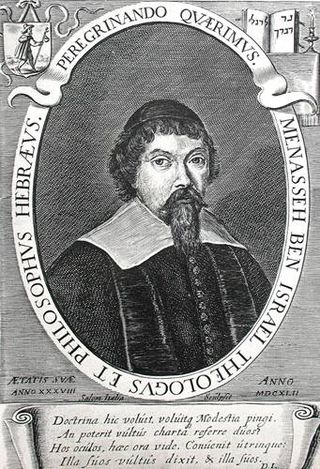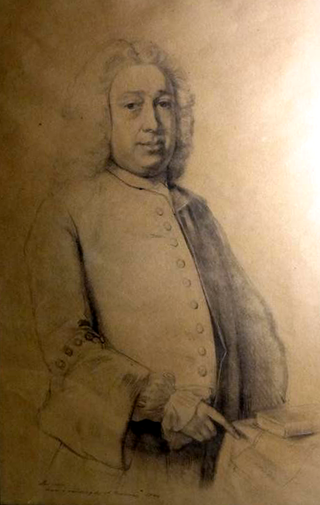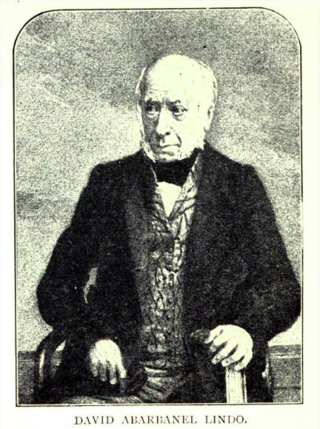
The Lindo family was a Sephardic Jewish merchant and banking family, which rose to prominence in medieval Spain. [1] [2] [3] [4] [5] [6]

The Lindo family was a Sephardic Jewish merchant and banking family, which rose to prominence in medieval Spain. [1] [2] [3] [4] [5] [6]
Manuel Lindo was a cosmographer and Chair of the Astronomy department at the University of Coimbra in the 16th century. He published a nautical guide in manuscript form in 1539. [7] [8] He was a dear friend of Amatus Lusitanus, who described him as the eminent astronomer. [9] He worked with Pedro Nunes, Abraham Zacuto, José Vizinho, João Faras to build instruments that made Europe's worldwide expansion possible. [10] [11]
Francisco Lindo was arrested for Judaism and Heresy in Évora, on 12 August 1644.
Francisco's son Joao Rodrigues Lindo married Contance Nunes of Guarda and lived in Campo Maior. Their son, Isaac (Lourenco), was born in Badajoz in 1638. He became a merchant in Tenerife, where he and his wife arrested by the Inquisition in 1656. After being held without trial for two years, Isaac and his wife were penanced and released. The family lived in France before settling in London in around 1670. [12] [13]
His brother, Antonio Rodriguez Lindo, a Lisbon merchant, was arrested on 9 October 1660 for Judaism and was condemned to public Abjuration at the Auto-da-fé of Lisbon on 17 September 1662.

One of the oldest and most esteemed of London Sephardic families, it traces its descent to Isaac Lindo. [14]
Isaac visited London in the early 1650s and was married there around 1653. Antonio Fernandez Carvajal and Abraham Chilon, who commissioned one of the first brokers medals in 1655, were his maternal uncles. [15]
He settled in London around 1670 where he became an elder of Bevis Marks Synagogue, one of the first Jewish brokers of the Royal Exchange, London in 1681 and a signatory of the *Ascamot of 1694. [16] [17] His children included:

For nine successive generations members of the family were sworn brokers of the City of London, until the registration of sworn brokers was abolished in 1886: [18] [19] [20]
Six of their brokers medals are on display at the Museum of London. [22]

The Lindos were closely related to many other "cousinhood" families of note in Britain, including the Mocatta, Goldsmid and the Montefiores.
Members of the family have been active in the affairs of the Sephardi community.
Moses Lindo (1760-1837) served as President of Board of Deputies of British Jews from 1817 to 1829. Moses' brother, David Abarbanel Lindo, married Sarah Lumbroso de Mattos and had no less than eighteen children, many of whom married into well known Sephardic families. [23]
David's son Nathaneel Lindo (1810-1889) was a City solicitor who operated the firm Lindo & Co., which had long acted as solicitors for the Spanish Portuguese Synagogue and the Italian consulate in London, a tradition which his sons: Gabriel (1838-1908) and Arthur Lindo (1839-1905) continued.
David Lindo Alexander, a grandson of David Abarbanel Lindo, was President of Board of Deputies of British Jews from 1903 to 1917.
In 1937, Frank Charles Lindo (1872-1938), a great grandson of David Abarbanel Lindo, donated funds to build the Lindo Wing at St Mary's Hospital, London.

Among the Jewish residents who made their mark on Kingston’s development, the Lindo family were outstanding.
When Alexandre Lindo arrived in Kingston in 1765, he rented a house on Port Royal Street, and by 1769 he had relocated to a rented house on Peter’s Lane. Alexandre had many children, seven with his first wife, Hannah, and after her death, sixteen with his second wife, Esther Salome. From early, Alexandre set up business on Princess Street, where over time, he acquired several properties. In 1788, he bought a row of houses on Port Royal Street leading to the harbour and established Lindo’s Wharf there. Per Stanley Mirvis' The Jews of Eighteenth-Century Jamaica: A Testamentary History of a Diaspora in Transition, Lindo "was perhaps the most notorious Jamaican Jewish slave trader, absentee planter, and moneylender at the end of the eighteenth century..." [24]
He owned multiple transatlantic vessels and traded in all types of merchandise. For example, one of his vessels, the Esther Lindo, described by Lloyd's Register as a constant trader on the London-Jamaica run, cleared Jamaica for London on May 28, 1790 laden with sugar, cotton, pimento, Nicaragua wood, coffee, ginger, rum, wine, silver, sweetmeats, tamarinds, balsam, copper, castor oil, and tortoise shell. [25] He owned numerous properties including Greenwich Park (the first steam powered plantation in Jamaica) and Pleasant Hill, a large coffee plantation. Lindo was a successful businessman who bought and traded goods captured by the British Royal Navy.
He supplied André Rigaud during the War of Knives and was close to a French jew who was executed while trying to spark a slave revolt in Jamaica in 1799. He made large loans to the French Government during the Peace of Amiens, negotiated by Charles Leclerc, to finance the Saint-Domingue expedition. When Britain declared war on France, on May 18, 1803, ending the Peace of Amiens, Lindo attempted to draw a draft in Paris, but the debt was dishonoured and Lindo was threatened with arrest. [26] [27] [28]
His eldest son, Abraham Alexander Lindo, was put in charge of the family business in Jamaica and Alexandre moved to London, where he was involved in trading, banking and insurance. He leased part of Roehampton estate called Putney Spot from Benjamin Goldsmid while constructing a mansion in Finsbury Square.
He was elected Parnas of Bevis Marks Synagogue in 1805. [29] [30] That year his sons subdivided Kingston Pen into small lots which then formed a mixed-race working-class township known as Lindo's Town. Lindo’s Town included areas now known as Trenchtown, Denham Town and Tivoli Gardens.
He died at Finsbury Square on March 12, 1812. [31] [32] [33]
Mocatta is a surname.

Manoel Dias Soeiro ;, better known by his Hebrew name Menasseh ben Israel or Menashe ben Israel, also known as Menasheh ben Yossef ben Yisrael, also known with the Hebrew acronym, MB"Y or MBI, was a Jewish scholar, rabbi, kabbalist, writer, diplomat, printer, publisher, and founder of the first Hebrew printing press in Amsterdam in 1626.
Spanish and Portuguese Jews, also called Western Sephardim, Iberian Jews, or Peninsular Jews, are a distinctive sub-group of Sephardic Jews who are largely descended from Jews who lived as New Christians in the Iberian Peninsula during the few centuries following the forced expulsion of unconverted Jews from Spain in 1492 and from Portugal in 1497. They should therefore be distinguished both from the descendants of those expelled in 1492 and from the present-day Jewish communities of Spain and Portugal.
The history of Jews in Charleston, South Carolina, was related to the 1669 charter of the Carolina Colony, drawn up by the 1st Earl of Shaftesbury and his secretary John Locke, which granted liberty of conscience to all settlers, and expressly noted "Jews, heathens, and dissenters". Sephardi Jews from London were among the early settlers in the city and colony, and comprised most of its Jewish community into the early 1800s.

The community of Sephardic Jews in the Netherlands, particularly in Amsterdam, was of major importance in the seventeenth century. The Portuguese Jews in the Netherlands did not refer to themselves as "Sephardim", but rather as "Hebrews of the Portuguese Nation." The Portuguese-speaking community grew from conversos, Jews forced to convert to Catholicism in Spain and Portugal, who rejudaized under rabbinical authority, to create an openly self-identified Portuguese Jewish community. As a result of the expulsions from Spain in 1492 and Portugal in 1496, as well as the religious persecution by the Inquisition that followed, many Spanish and Portuguese Jews left the Iberian peninsula at the end of the 15th century and throughout the 16th century, in search of religious freedom. Some migrated to the newly independent Dutch provinces which allowed Jews to become residents. Many Jews who left for the Dutch provinces were crypto-Jews. Others had been sincere New Christians, who, despite their conversion, were targeted by Old Christians as suspect. Some of these sought to return to the religion of their ancestors. Ashkenazi Jews began migrating to the Netherlands in the mid-seventeenth century, but Portuguese Jews viewed them with ambivalence.

David Lindo Alexander was an English barrister and Jewish community leader.

Sampson Gideon was a British banker and philanthropist active in the City of London during the Georgian era. Gideon is most prominently known for his financing of the Hanoverian-Whig government's suppression of the Jacobite rising of 1745, subsequently becoming a trusted "adviser of the Government" who supported the passage of the Jewish Naturalisation Act 1753. Historian James Picciotto, in his 1875 book Sketches of Anglo-Jewish History described Gideon as the "Rothschild of his day" and the "pillar of state credit".
The history of the Jews in Jamaica predominantly dates back to migrants from Spain and Portugal. Starting in 1509, many Jews began fleeing from Spain because of the persecution of the Holy Inquisition. When the English captured Jamaica from Spain in 1655, the Jews who were living as conversos began to practice Judaism openly. By 1611, the Island of Jamaica had reached an estimated population of 1,500 people. An estimated 75 of those people were described as "foreigners," which may have included some Portuguese Jews. Many Jamaican Jews were involved in the Atlantic slave trade, both owning and trading in enslaved Black people.
David Alfred Mocatta (1806–1882) was a British architect and a member of the Anglo-Jewish Mocatta family.

Sir Moses Haim Montefiore, 1st Baronet, was a British financier and banker, activist, philanthropist and Sheriff of London. Born to an Italian Sephardic Jewish family based in London, after he achieved success, he donated large sums of money to promote industry, business, economic development, education and health among the Jewish community in the Levant. He founded Mishkenot Sha'ananim in 1860, the first Jewish settlement outside the Old City of Jerusalem.

Lopes Suasso is the name of an important aristocratic Portuguese Jewish family that played an important role in banking.
Joseph Pallache, was a Jewish Moroccan merchant and diplomat of the Pallache family, who, as envoy, helped his brother conclude a treaty with the Dutch Republic in 1608.
Abigail Lindo was a British lexicographer. She was the first British Jew to compile a Hebrew-English dictionary and is considered to be the only woman to have made a significant contribution to philology in the nineteenth century.
Elias Mocatta (1798–1881) was a British merchant and financier, significant in the early credit history of Venezuela and other South American countries.
Mocatta is a Sephardic Anglo-Jewish surname. Notable people with the name include:
Alexander Bravo, sometimes spelled Alexandre Bravo, was a Jamaican merchant, politician and planter who served as Auditor-General of Jamaica. Bravo was the first Jew to be elected to the House of Assembly of Jamaica.
Emanuel Lousada was a British merchant, planter and politician with interests in Jamaica and Barbados. He was the High Sheriff of Devon from 1842 until 1843, making him the first Jew to hold the title in a county outside of the Sheriff of London, which had been held first by David Salomons in 1835. Lousada was associated with Peak House, Sidmouth. Lousada owned more than 400 African slaves on his sugarcane plantations in the British West Indies at the time of the Slavery Abolition Act 1833. He died a wealthy man, leaving £100,000 in his will.

David Lindo (1772–1852) was an English Sephardi communal worker and elder of Bevis Marks Synagogue.
Moses Lindo was a British indigo sorter, merchant, planter and Inspector General of Indigo, Drugs & Dyes in the Province of South Carolina.
Elias Haim Lindo was a British Sephardic Jewish merchant, author and historian.
{{cite book}}: CS1 maint: numeric names: authors list (link){{cite book}}: CS1 maint: location missing publisher (link)